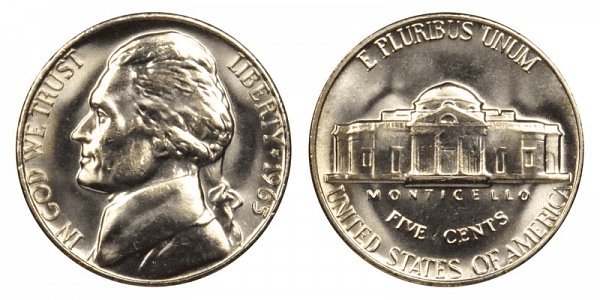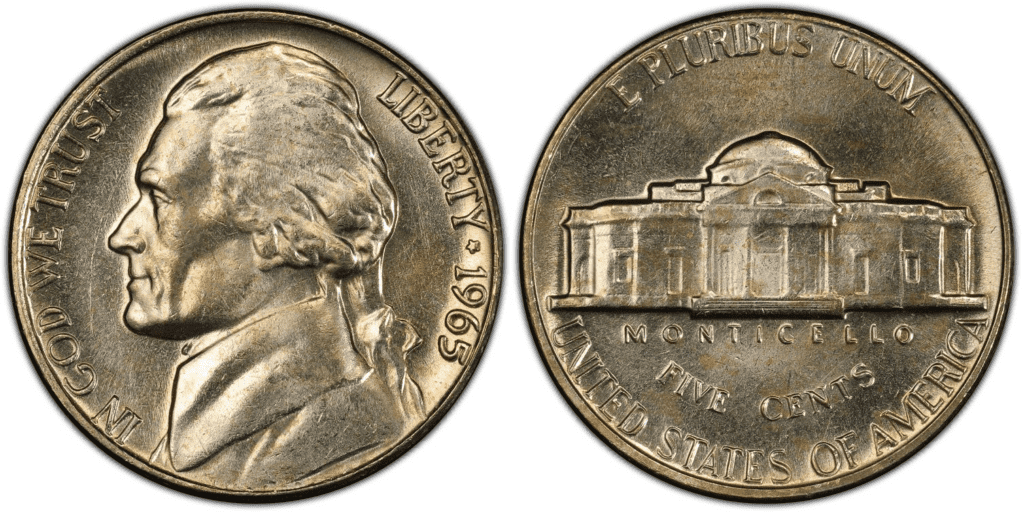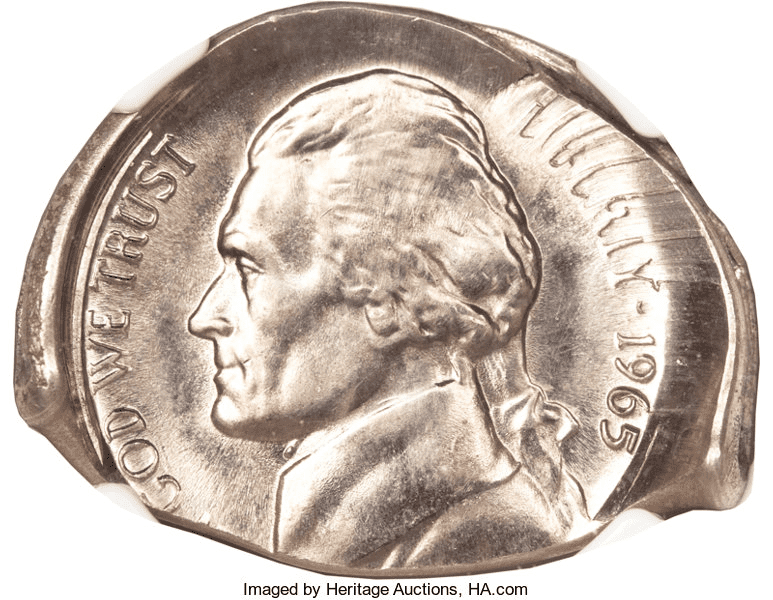What Is the 1965 Jefferson Nickel Made Of?
The Buffalo Nickel, which had been used since 1913, was replaced by the Jefferson Nickel in 1938. Thomas Jefferson, the third president of the United States (1801–1809), is shown on the coin’s obverse, along with the phrase “IN GOD WE TRUST.”
Felix Schlag created and sculpted both the obverse and reverse sides. The image of Monticello, the Virginia home of President Thomas Jefferson, can be seen on the reverse of the coin, which also includes the words “E PLURIBUS UNUM,” “MONTICELLO,” “FIVE CENTS,” and “UNITED STATES OF AMERICA.”
The face value of the 1965 Jefferson nickel is $5, and it features rounded corners. The 1965 Nickel has a silver tone despite having no silver content since it comprises 75% copper and 25% nickel cladding. This metal composition gives the Jefferson nickel a total weight of just 5g.
136,131,380 1965 Nickels were produced in Denver, San Francisco, and Philadelphia. Still, there are no mint marks because of a 1965 law passed by Congress to outlaw coin collecting and increase the number of coins in active circulation. In 1968, Mint Marks would resume.
The construction of the St. Louis Arch, the space race’s escalating competition, the Rolling Stones’ global tour, the passage of the Voting Rights Act as a result of the Selma march, and the Vietnam War all took place in 1965. Race riots broke out in Watts, California, Malcolm X was assassinated, NASA’s Mariner 4 flew over Mars, and Muhammad Ali faced Sonny Liston. The United States also occupied the Dominican Republic.
1965 Jefferson Nickel Varieties
1965 Jefferson Nickel (No Mint Mark)
Edge: Plain
Place of minting: Philadelphia/Denver/San Francisco
Year of minting: 1965
Face Value: $0.50
Quantity produced: 136,131,380
Composition: 75% Copper, 25% Nickel
Mass: 5 grams
Diameter: 21.2 millimeters
Thickness: 1.75 millimeters

1965 Jefferson Nickel (Full Steps)
Edge: Plain
Place of minting: Philadelphia/Denver/San Francisco
Year of minting: 1965
Face Value: $0.50
Quantity produced: 136,131,380
Composition: 75% Copper, 25% Nickel
Mass: 5 grams
Diameter: 21.2 millimeters
Thickness: 1.75 millimeters

The Jefferson Nickels with at least five whole steps visible at the base of Monticello on the reverse are referred to as “Full Steps” circulation strikes. In general, the label is used to designate coins that have been fully struck. To be distinguished, there must be no deviation from the steps caused by weak strikes, contact marks, or planchet problems.
1965 Jefferson Nickel Foldover Strike Error

A planchet or coin that is struck on edge and folds in half is known as a foldover strike.
The coin or planchet may enter the striking chamber while it is rotating. Both the feeder finger and ejection arm have the ability to kick it into a vertical position. It can also roll upon its edge and enter the striking chamber. Seeing this degree of error is exceedingly rare, because this type of glaringly obvious fault was usually picked up by Mint employees, and the coin would be destined to be remelted.
How Much Is 1965 Jefferson Nickel Worth Today?
Due to its absence of precious metals, the melt value of the 1965 Nickel is approximately $0.0567, making it basically worthless to melt down or to collect in the hope of increasing value.
| Coin | G | VG | F | VF | MS60 | MS65 |
| 1965 Nickel (Regular Strike) | $0.05 | $0.05 | $0.05 | $0.05 | $0.28 | $5.70 |
How Does The Grading System Work?
The Sheldon Scale is used by numismatists to provide a numerical value to coins. The Sheldon Scale goes from poor (P-1) to perfect mint state (P-1) (MS-70). Coins were originally evaluated using words to reflect their condition (Good, Fair, Excellent, Etc.). Unfortunately, coin collectors and dealers had different ideas about what each of these terms represent.
Professional numismatists joined together in the 1970s and established coin grading standards. These numismatists now assign grades at key places on the seventy-point scale, using the most regularly utilized numeric points in conjunction with the original adjective grade. The following are the most common coin grades:
- (P-1) Poor – Indistinguishable and probably damaged; if used, must have a date and mintmark; otherwise, rather battered.
- (FR-2) Fair – Nearly smooth, but without the damage that a coin graded Poor often possesses. The coin must have enough detail to be identified.
- (G-4) Fair – Inscriptions have merged into the rims in some areas, and important elements have been mostly erased.
- (VG-8) Very Good- A little weathered, but all of the primary design elements are visible, albeit faintly. There is little if any, central detail left.
- (F-12) Good – The item is very worn, yet the wear is even, and the overall design details stand out clearly. Rims are almost completely isolated from the field.
- (VF-20) Very Fine – Moderately weathered, with some finer features still visible. The motto or all letters of LIBERTY are readable. Both sides of the coin have entire rims that are separated from the field.
- (EF-40) Extremely Fine – Gently used; all gadgets are visible, and the most important ones are bold. The finer details are bold and clear, however, light wear may be seen.
- (AU-50) Uncirculated – Slight evidence of wear on the coin’s design’s high points; may have contact marks; eye appeal should be adequate.
- (AU-58) Uncirculated Choice – Slight traces of wear, no severe contact marks, almost full mint shine, and great eye appeal.
- (MS-60) Mint State Basal – Strictly uncirculated; no indication of wear on the coin’s highest points, but an unsightly coin with reduced luster, visible contact marks, hairlines, and other flaws.
- (MS-63) Mint State Acceptable – Uncirculated, but with contact scratches and nicks, little reduced shine, but otherwise appealing appearance. The strike is weak to average.
- (MS-65) Mint State Choice – Uncirculated with great mint shine, very little contact blemishes, and exceptional eye appeal. The strike is unusually severe.
- (MS-68) Mint State Premium Quality – Uncirculated with superb luster, no obvious contact marks to the naked eye, and exceptional eye appeal. The strike is quick and appealing.
- (MS-69) Almost Perfect Mint State – Uncirculated with perfect brilliance, a sharp and appealing strike, and extremely good eye appeal. A near-perfect coin with minor imperfections in the planchet, strike, and contact markings (seen only under 8x magnification).
- (MS-70) Mint State Perfect – Under 8x magnification, there are no tiny imperfections discernible; the strike is crisp, and the coin is perfectly centered on a beautiful planchet. Rarely seen on a coin, this coin is bright and whole, with original luster and exceptional eye appeal.
Where To Buy Or Sell 1965 Jefferson Nickel?
There are several options for buying and selling nickels from 1965. You might discover one or two in your pocket change since they’re still in use. Of course, the best sites to seek common, widely used coins are eBay and Etsy. Before selling the coin, look for any tiny faults or unique features, such as the five distinct stairs on the Monticello structure, that could increase its worth. If you’re not sure or you believe you have a special coin, have it evaluated by a professional, either in person or online.
FAQs
Where is the mint mark on a 1965 nickel?
Due to the Coinage Act of 1965, no coins from 1965 to 1968 featured mint marks.
Are any 1965 nickels silver?
No,1965 Nickels were minted using a 75% Copper, 25% Nickel composition.
Why are people hoarding nickels?
The usefulness of saving nickels as a possible investment and inflation hedge has been brought up by several Americans. Nickel has usage in items other than coin manufacture; it is a component of automobile batteries, among other things.
What nickels should I keep?
There are some very rare nickels out there, but Jefferson nickels don’t make the top 10. In general, however, as a budding collector, you’re looking for nickels in exceptional condition or those with clear errors such as doubling or clipping.
